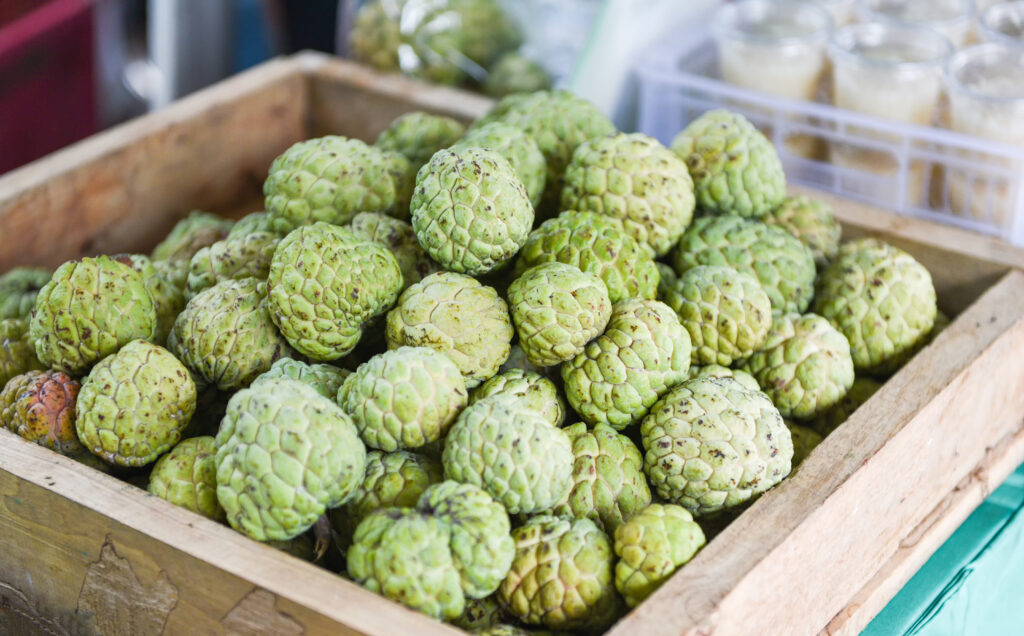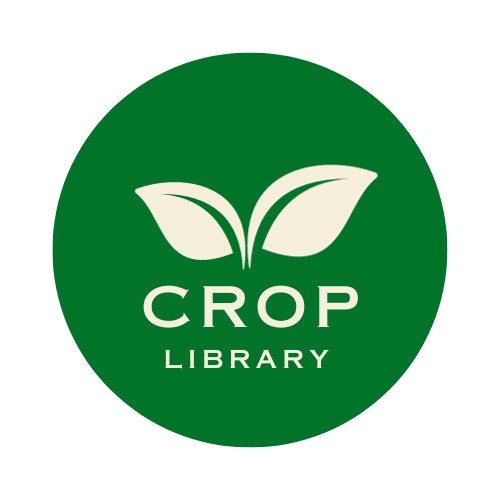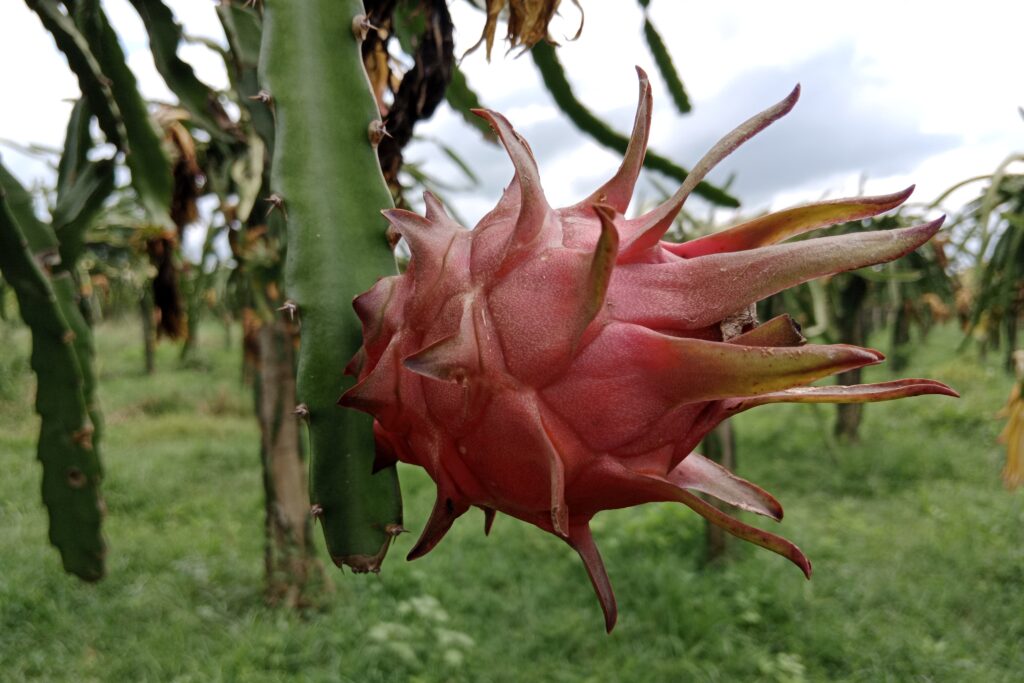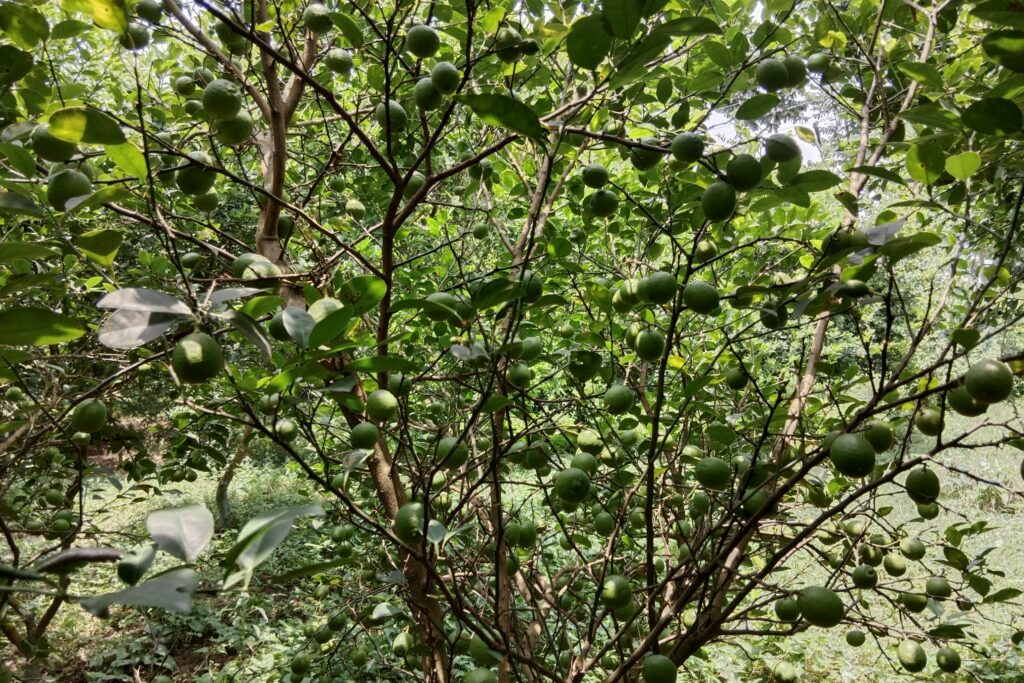Custard Apple Farming
The custard apple (Annona squamosa), also known as sugar apple or sweetsop, is a tropical fruit tree prized for its sweet, creamy, and aromatic fruit. Custard apple farming profit per acre begins with an initial investment of NRs. 349,300 in the first year, covering costs such as land preparation, saplings, fertilizers, irrigation setup, labor, pest control, and miscellaneous expenses. From the second year onward, the annual maintenance cost ranges between NRs. 50,000 and NRs. 100,000, making it a manageable and potentially profitable agricultural venture with proper care and management.

The break-even point in custard apple farming profit per acre is typically achieved by the 5th or 6th year, as the cumulative income surpasses the initial investment and ongoing maintenance costs. The highest income is generated during the 6th to 15th year, with an annual income of approximately NRs. 1,458,000, marking the period of peak profitability. Even after 20 years, the trees continue to produce fruit and generate income, although at a reduced yield, ensuring long-term sustainability for the orchard.
Over a span of 20 years, the net profit from custard apple farming per acre is estimated to be around NRs. 2.34 million, making it a highly profitable venture with proper management and care. This analysis highlights the potential of custard apple cultivation as a sustainable and lucrative agricultural investment.
Land Preparation
To guarantee adequate soil aeration and drainage, the field should be thoroughly ploughed and leveled after being cleared of weeds, debris, and leftover agricultural residues. Raised beds or ridges can be prepared to avoid waterlogging in places with inadequate drainage. To aid in planting and root development, 60 m³ pits should also be excavated.
Soil Type
Well-drained, sandy loam or loamy soils that are high in organic matter and have a pH between 6.0 and 7.5 are suitable for custard apple growth. They should not be used in thick clay or wet soil because these conditions can lead to root rot. As long as the soil is well-drained, the crop can grow on shallow soils and even saline soils.
Climatic Requirements
In warm, tropical, or subtropical settings, custard apples flourish; the ideal growing temperature range is 25°C to 35°C. Because they are vulnerable to frost and cannot tolerate extended cold, they favor mild winters and warm, humid climates. Although the trees can withstand drought once established, moderate annual rainfall of 600–1,000 mm is excellent. Custard apples are able to thrive in a variety of elevations within their ideal climate since they can be grown from sea level to 1,000 meters above mean sea level.
Major Cultivars
Popular cultivars include:
a). Balangar
Known for its high yield and good fruit quality.
b). Arka Sahan
Resistant to drought and suitable for dry regions.
c). Red Sitaphal
Known for its reddish fruit skin and sweet taste.
d). Local Varieties
Many regions have their own locally adapted cultivars.
Planting
Well-established grafts should be planted in the center of the pit to ensure proper root development and optimal growth conditions.

a). Planting Season
The ideal planting season for custard apples spans from March to September, with the best time being during the monsoon season to ensure sufficient moisture for proper establishment and growth.
b). Spacing
It is advised to plant 5 m by 5 m apart, and to support the plants and keep them from lodging, staking should be available.
c). Pit Preparation
To prepare pits for planting, dig holes measuring 60 cm in length, width, and depth. These pits should be filled with a mixture of topsoil and 10 kg of compost, ensuring a rich and fertile base for the plants. This mixture provides essential nutrients, promotes healthy root development, and supports robust growth, creating an ideal environment for the plants to thrive. Proper pit preparation is a crucial step in establishing a strong foundation for healthy and productive cultivation.
d). Planting Method
Place the sapling in the center of the pit, ensuring the root ball is covered with soil. Water thoroughly after planting.
e). Number of Plants per Acre
Approximately 162 plants can be accommodated per acre.
Intercropping
During the initial years of custard apple cultivation, intercropping with short-duration crops such as legumes, vegetables, or pulses can be practiced maximizing land use and generate additional income. This practice is particularly beneficial during the rainy and winter seasons, when these crops thrive. However, it is important to avoid intercropping with tall or aggressive crops, especially during the summer season, as they may compete for nutrients, water, and sunlight, negatively affecting the growth of young custard apple plants. Seasonal planning ensures optimal resource utilization and enhances overall farm productivity.
Irrigation
Young custard apple plants require regular watering to establish roots, while mature trees, though drought-tolerant, need irrigation during dry spells, especially during flowering and fruit development. Avoid overwatering to prevent root rot. Sandy soils need frequent watering due to poor water retention, while clay soils retain moisture longer.

Increase irrigation in hot, dry periods and reduce it during rains to avoid waterlogging. Mulching conserves moisture, regulates soil temperature, and suppresses weeds. Drip irrigation is efficient, delivering water directly to roots and minimizing waste. Use good-quality water to prevent salinity issues. Adjust irrigation based on growth stage, soil, climate, and local conditions.
Water Requirement for Custard Apple
| Growth Stage | Duration | Water Requirement (Liters/Tree/Day) | Frequency | Remarks |
| Planting to Establishment | 0–3 months after planting | 5-10 liters | Every 2–3 days | Ensure soil is moist but not waterlogged. Critical for root establishment. |
| Young Sapling Stage | 3–12 months after planting | 10–20 liters | Every 3–4 days | Increase water as the root system develops. Mulching helps retain moisture. |
| Vegetative Growth Stage | 1–3 years after planting | 20–15 liters | Every 4–5 days | Water deeply to encourage deep root growth. Reduce frequency in rainy season. |
| Flowering Stage | 3–4 years after planting | 20–30 liters | Every 5–7 days | Ensure consistent moisture to support flowering and fruit set. |
| Fruit Development Stage | 4–5 years after planting | 30–40 liters | Every 7–10 days | Water stress during this stage can lead to fruit drop. |
| Mature Tree Stage | 5+ years after planting | 50–60 liters | Every 10–14 days | Mature trees are drought-tolerant but require adequate water for yield. |
Fertilizer and Manure
Apply 10 kg of manure per tree when it is first planted and then increase the amount of manure by 15% every year. Test the soil every two to three years to determine its nutrient status and modify fertilizer dosages as necessary. After applying fertilizers in a circular trench around the tree canopy and completely mixing them with the soil, the trees should be adequately watered. For best results, use organic alternatives like compost, vermicompost, or biofertilizers in addition to chemical fertilizers to implement sustainable nutrient management techniques. Below are general fertilizer recommendations, which may vary based on soil fertility, climate, and local conditions.
Fertilizer Requirement for Custard Apple
| Durations | N (g/tree/year) | P (g/tree/year) | K (g/tree/year) | Frequency |
| 0–6 months after planting | 100 | 50 | 100 | Apply in 3 equal split doses |
| 6–12 months after planting | 150 | 75 | 150 | Apply in 3 equal split doses |
| 1–3 years after planting | 200 | 100 | 200 | Apply in 3 equal split doses (March, June & October) |
| 3–4 years after planting | 250 | 125 | 250 | Apply in 3 equal split doses (March, June & October) |
| 4–5 years after planting | 300 | 150 | 300 | Apply in 3 equal split doses (March, June & October) |
| 5+ years after planting | 500 | 250 | 500 | Apply in 3 equal split doses (March, June & October) |
Weed Control
For custard apple trees to grow healthily, weed control is essential, especially in the first few years of growth, as it reduces competition for water and nutrients. To keep the space surrounding the plants clear of undesirable weeds, regular weeding should be done. Furthermore, mulching with organic materials like straw or dried leaves can help control temperature, retain moisture, and enhance soil structure while also successfully inhibiting weed growth. Combining these methods creates an atmosphere that is conducive to the trees’ growth.
Pest and Disease Management
Common Pests
a). Fruit borers
The fruit borer, Heterographis bengalella Ragonot (Syn: Anonaepestis bengalella), belonging to the Lepidoptera order and Pyralidae family, is a significant pest of custard apple. The larvae bore into the fruits, causing direct damage by feeding on the pulp and seeds, leading to fruit rot and premature drop. Infested fruits often exhibit entry holes and frass, reducing marketability and yield. Management strategies include regular monitoring, removal of infested fruits, and application of biological controls or insecticides when necessary. Proper orchard sanitation and timely interventions are essential to minimize damage and ensure healthy fruit production.
b). Mealybugs
Mealybugs are common pests in custard apple cultivation, appearing as small, soft-bodied insects covered with white, powdery wax. They typically cluster on leaves, stems, and fruits, sucking sap and weakening the plant. Infestations lead to stunted growth, leaf yellowing, and fruit deformation. Additionally, mealybugs excrete honeydew, promoting sooty mold growth, which further affects photosynthesis and fruit quality. Effective management includes regular monitoring, biological control using natural predators like ladybugs, and chemical treatments if necessary. Proper orchard hygiene and removal of infested plant parts are also crucial to prevent spread.
c). Scale insects
Scale insects, particularly Ceroplastes floridensis Comstock (Hemiptera: Coccidae), are common pests in custard apple cultivation. These small, immobile insects attach themselves to leaves, stems, and fruits, feeding on plant sap and weakening the tree. Heavy infestations can lead to yellowing of leaves, stunted growth, and reduced fruit quality. Additionally, scale insects excrete honeydew, which promotes the growth of sooty mold, further affecting photosynthesis and fruit appearance. Effective management includes regular monitoring, pruning of infested branches, and the use of natural predators like ladybugs or targeted insecticidal treatments. Maintaining orchard hygiene and early intervention are crucial to control scale insect populations and minimize damage.
Common Diseases
a). Anthracnose
The disease symptoms begin with infection at the blossom-end of the fruit, which then spreads across the entire fruit surface, causing affected fruits to shrivel and either cling to the tree or fall. Necrotic spots, measuring 2-10 mm in diameter, appear on unripe fruits and develop into dark brown to black spots, which eventually coalesce and cover the entire fruit.
b). Leaf Spot
Small, dark brown to black spots on the leaves are the hallmark of the widespread fungal ailment known as “leaf spot disease” in custard apples, which is brought on by Alternaria spp. These patches may combine and cause severe leaf damage, yellowing, and early defoliation. They frequently feature concentric rings. Severe infections can affect fruit quality and yield, weaken the tree, and decrease photosynthesis.
Splashing water or wind helps the fungus spread, and it grows best in warm, humid environments. Keeping the orchard clean, eliminating and disposing of diseased plant matter, and using fungicides as required are all examples of management techniques. Alternaria leaf spot can be prevented and controlled with regular monitoring and proper air circulation around the plants.
c). Black Canker
Black canker, caused by the fungus Phomopsis annonacearum (Bond) Mont., is a significant disease in custard apple cultivation. It primarily affects the stems, branches, and fruits, leading to the formation of dark, sunken cankers with cracked margins. Infected fruits develop black, irregular lesions, often causing them to rot and drop prematurely.
The disease can also cause dieback of branches, weakening the tree and reducing overall productivity. Warm, humid conditions favor the spread of the fungus. Management includes pruning and destroying infected plant parts, maintaining orchard hygiene, and applying fungicides to control the disease. Regular monitoring and proper cultural practices are essential to minimize the impact of black canker on custard apple trees.
Harvesting
Custard apple trees typically begin bearing fruit 3–4 years after planting, with fruits ready for harvest when they turn pale green or yellowish and the segments start to separate slightly. Harvesting is usually done manually by handpicking to avoid damage, as the fruit has a short shelf life and is prone to bruise if not handled carefully. After 4–5 years of planting, the average yield ranges from 80 to 100 fruits per tree annually.
Cost of Investment Per Acre for Custard Apple Farming
| S.N. | Categories | Estimated Cost (NRs.) |
| 1 | Land Preparation (plowing, leveling, pit digging) | 50,000 |
| 2 | Custard Apple Saplings (162 plants @ NRs. 150 each) | 24,300 |
| 3 | Fertilizers and Manure | 65,000 |
| 4 | Irrigation System Setup (Drip) | 100,000 |
| 5 | Labor Costs (Planting, Maintenance) | 50,000 |
| 6 | Pest & Disease Control | 30,000 |
| 7 | Miscellaneous Costs (Equipment, Mulch, etc.) | 30,000 |
| Total Initial Investment | 349,300 |
Annual Maintenance Cost (From Second Year Onwards)
The annual maintenance cost for custard apple cultivation, starting from the second year onwards, typically ranges between NRs. 50,000 and NRs. 100,000 per acre. This cost covers essential activities such as fertilization, irrigation, pest and disease control, pruning, weeding, and labor for general orchard upkeep. Proper maintenance ensures healthy tree growth, optimal fruit production, and long-term sustainability of the orchard. By investing in regular care, farmers can maximize yields and maintain the profitability of their custard apple cultivation over the years.
Income from 1 Acre of Custard Apple Cultivation
| Year | Yield per Tree (kg) | Total Yield (kg/Acre) | Market Price (NRs/kg) | Total Income (NRs.) |
| 3rd Year | 10 | 1,620 | 80 | 129,600 |
| 4th Year | 20 | 3,240 | 80 | 259,200 |
| 5th Year | 25 | 4,050 | 80 | 324,000 |
| 6th–15th Year | 60 | 9,720 | 150 | 1,458,000 |
| 16th–20th Year | 40 | 6,480 | 200 | 1,296,000 |
| 20+ Years | 20 | 3,240 | 200 | 648,000 |
Analysis of Custard Apple Farming Profit Per Acre
Custard apple cultivation involves an initial investment of NRs. 349,300 in the first year, covering land preparation, saplings, fertilizers, irrigation setup, labor, pest control, and miscellaneous costs. From the second year onwards, the annual maintenance cost ranges between NRs. 50,000 and NRs. 100,000, averaging around NRs. 75,000 per year.
Over a span of 20 years, the cumulative income from the orchard is substantial. In the 3rd year, the income is NRs. 129,600, increasing to NRs. 259,200 in the 4th year and NRs. 324,000 in the 5th year. The orchard reaches its peak profitability during the 6th to 15th year, generating an annual income of NRs. 1,458,000.
From the 16th to 20th year, the income remains significant at NRs. 1,296,000, and even after 20 years, the orchard continues to yield an income of NRs. 648,000. The total income over 20 years amounts to NRs. 4,114,800.
On the cost side, the total maintenance cost over 19 years averages NRs. 75,000 annually, totaling NRs. 1,425,000. Adding the initial investment, the total costs over 20 years come to NRs. 1,774,300. Subtracting the total costs from the total income, the net profit over 20 years is approximately NRs. 2,340,500.
This translates to an average annual profit of NRs. 117,025 over the 20-year period, demonstrating that custard apple cultivation is a profitable and sustainable agricultural venture with proper management.


